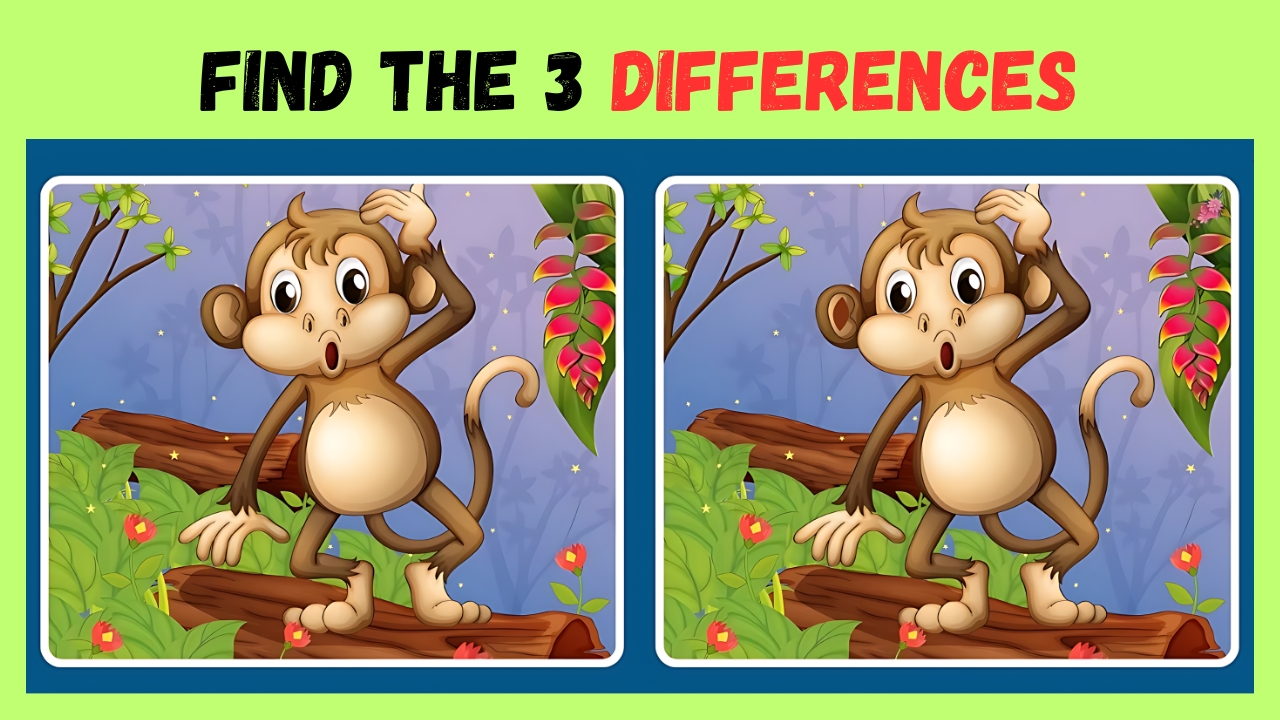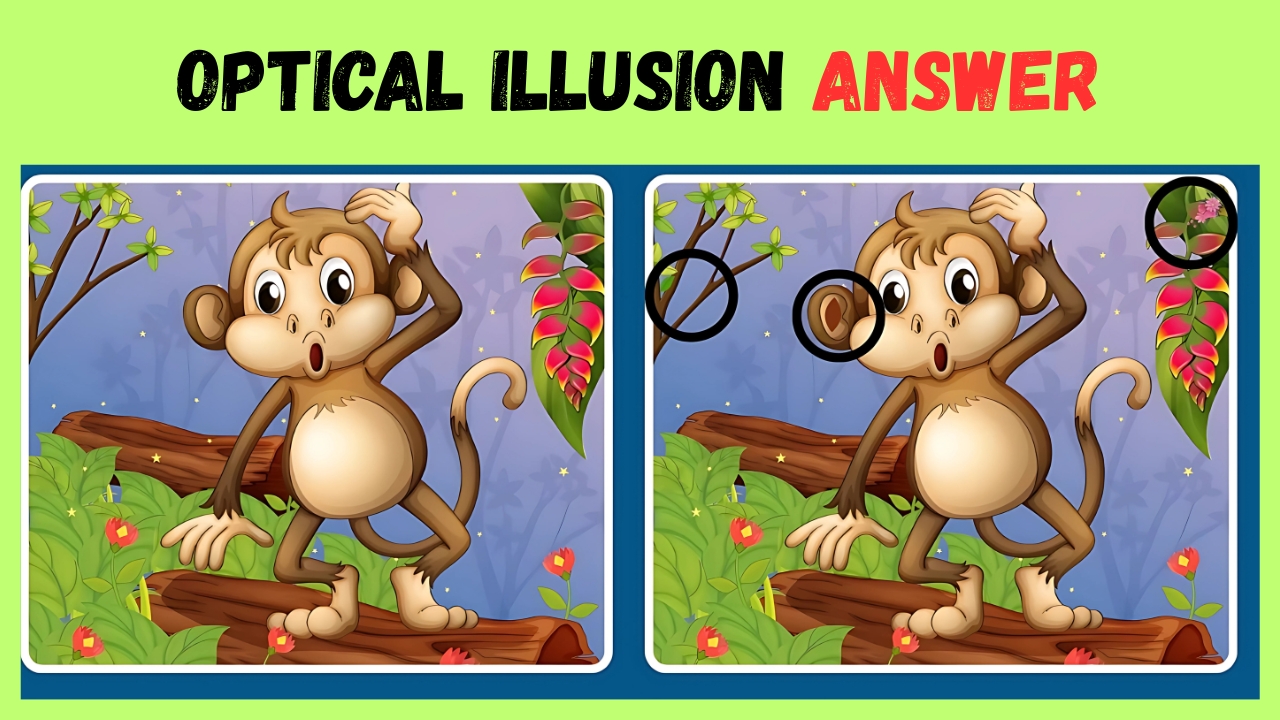Monkey Challenge : you’re scrolling through your phone, and suddenly you stumble upon two nearly identical images of an adorable monkey. Someone challenges you to find three differences between them in just ten seconds. Sounds easy, right? Think again! This particular optical illusion has been stumping people worldwide, and there’s a fascinating reason why.
What Makes This Monkey Puzzle So Tricky?
The beauty of this challenge lies in its deceptive simplicity. At first glance, both monkey images appear completely identical. The cute primate sits among lush greenery, surrounded by leaves and flowers, creating a peaceful jungle scene. But hidden within this seemingly perfect mirror image are three subtle changes that require serious focus to detect.
What makes this puzzle particularly challenging is the time constraint. Ten seconds might seem reasonable, but when you’re scanning two detailed images for tiny differences, those seconds fly by faster than you’d expect. Your brain naturally wants to see the images as identical, making it work overtime to spot the discrepancies.
Why Your Brain Loves These Visual Puzzles

Engaging with optical illusions like this monkey challenge isn’t just entertainment – it’s actually giving your brain a valuable workout. When you focus intensely on finding differences, several cognitive processes activate simultaneously. Your visual attention sharpens, pattern recognition improves, and working memory gets strengthened.
Think of it like going to the gym, but for your mind. Each time you tackle one of these puzzles, you’re essentially doing mental push-ups. Regular practice with spot-the-difference challenges can improve your concentration in daily life, help you notice details others miss, and even boost your problem-solving abilities.
Research suggests that people who regularly engage with visual puzzles maintain sharper cognitive abilities as they age. It’s like investing in your mental health while having fun – a perfect combination that explains why these challenges have become so popular across social media platforms.
Smart Strategies for Conquering the Challenge
Before diving into this specific monkey puzzle, let’s talk strategy. Many people approach these challenges randomly, letting their eyes dart around both images hoping to stumble upon differences. However, successful puzzle solvers use systematic techniques that dramatically improve their success rate.
Start by dividing each image into sections – top, middle, and bottom, or left, center, and right. Focus on one section at a time, comparing the same area in both images before moving on. This methodical approach prevents you from missing obvious differences and helps manage that ten-second time limit more effectively.
Pay special attention to edges and borders within the images. Differences often appear in areas where different elements meet – like where the monkey’s fur meets the background, or where leaves connect to branches. These transition zones are common hiding spots for subtle changes.
Breaking Down the Monkey Mystery
Now, let’s examine what makes this particular challenge so special. The monkey sits peacefully in a natural setting, surrounded by various plants and flowers. The scene includes intricate details like individual leaves, textured tree bark, and delicate flower petals – all potential locations for hidden differences.
According to the solution, the three differences are cleverly placed in different areas of the image. One appears in the foliage on the left side, where a leaf goes missing in one version. Another difference involves the monkey’s ear, where subtle shape variations create the second challenge. The third difference hides in the upper right corner, involving a pink flower that appears in one image but vanishes in the other.
These placement choices aren’t random. Puzzle creators deliberately position differences in areas that challenge different aspects of visual processing. Some differences test your ability to notice missing elements, others focus on shape variations, and some examine color or pattern changes.
Why Most People Struggle With This Type of Challenge
The human visual system, while remarkably sophisticated, has interesting limitations that these puzzles exploit. Our brains are designed to quickly categorize and make sense of visual information, often filling in gaps or overlooking small inconsistencies to create a coherent picture.
When viewing two similar images, your brain tends to focus on the overall scene rather than minute details. This survival mechanism served our ancestors well when they needed to quickly identify threats or opportunities in their environment. However, it works against us when we’re trying to spot small differences in puzzle images.
Additionally, the time pressure creates stress that can actually impair visual processing. When you know you only have ten seconds, anxiety can cause tunnel vision, making you miss differences you might easily spot with unlimited time. This psychological element adds another layer of difficulty to an already challenging task.
Building Your Difference-Detection Skills
Don’t worry if you couldn’t spot all three differences in your first attempt – most people can’t! Like any skill, becoming proficient at these visual challenges requires practice and patience. Start with easier puzzles that have more obvious differences, then gradually work your way up to trickier challenges like this monkey image.
Try varying your approach with each attempt. Sometimes stepping back from the screen or changing your viewing angle can help differences pop out. Other times, quickly alternating your focus between the two images creates a flickering effect that makes changes more obvious.
Consider practicing with physical spot-the-difference books as well as digital versions. The different mediums can help train your eyes to adapt to various presentation styles and lighting conditions. Some people find they perform better with printed puzzles, while others excel with backlit screens.
The Social Element That Makes It Even More Fun
Part of what makes challenges like this monkey puzzle so engaging is their social nature. Sharing these puzzles with friends and family creates friendly competition and bonding opportunities. Everyone approaches visual problems differently, so discussing strategies with others can reveal new techniques you hadn’t considered.
Children particularly benefit from these activities, as they’re still developing their visual processing skills and attention spans. Working through difference puzzles together can become quality family time that also supports cognitive development. Plus, kids often surprise adults by spotting differences that mature eyes miss – their fresh perspective can be a real advantage.
Optical Illusion Answer

Whether you successfully found all three differences or struggled to spot even one, remember that the real value lies in the mental exercise itself. Each attempt strengthens your visual attention and trains your brain to notice subtle details in everyday life.
Consider setting aside a few minutes each day for visual puzzles like this monkey challenge. You’ll likely notice improvements in your focus and observation skills that extend far beyond puzzle-solving. Many people report becoming more detail-oriented at work and noticing things in their environment they previously overlooked.
This particular monkey optical illusion represents everything that makes visual challenges so compelling – the perfect balance of difficulty and solvability, beautiful imagery that draws you in, and that satisfying “aha!” moment when differences finally reveal themselves.